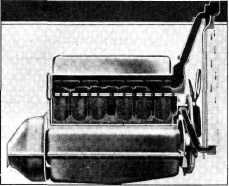1942 - 1947 CHEVROLET SHOP MANUAL
Section 6 - Engine
|
|
|||
|
6-50 |
|||
|
|
|||
|
proper
temperature for the type anti-freeze to be used.
Check the
thermostat for fully OPEN and CLOSED
temperatures as follows:
Fully Open
Place the
thermostat in hot water 25° above the
temperature stamped on the thermostat valve. The bellows should be completely
submerged and the ■ water
agitated thoroughly. Under this
condition the valve should open fully.
Closed
Repeat the
above in water 10° below the indicated temperature on the valve. Under this
condition the valve
should close completely. Reinstall thermostat if found OK, using a
new housing
gasket.
7. Fill the cooling system with proper quantity
of anti-freeze and water
according to instructions
by manufacturer of the anti-freeze being used.
NOTE—Be sure to make allowance
for additional amount of anti-freeze or solution if ear is equipped
with a hot water heater.
8. Warm up engine. Re-tighten all cylinder head
bolts. Check radiator, water
pump and all hose connections
for leaks with engine hot.
9. Check and adjust valve clearance. Be sure to
normalize engine prior to
making this check and
adjustment—Follow Instructions, "Valve Adjustment Procedure" in this Shop Manual.
Lubricate all valve stems to insure free movement of the valves in the guides. Adjust
the valve clearance as
follows:
Intake....................006" to .008" Hot
Exhaust..................013" to .015" Hot
NOTE—The reason for the check
and adjustment of valves here even though the engine seems to perform and
sound OK, is due to the fact that the cylinder head bolts have been
tightened— this decreases the valve clearance and may cause the valves to
hold open and not only result in a very unsatisfactory performing
engine but may burn and warp the valves and cause expense to the
owner.
CARE OF THE COOLING SYSTEM
Every car
and truck requires periodic cooling system service. Seasonal changes make
this service very important due
to the use of anti-freeze solutions. In many instances this service
consists of draining and
refilling the cooling system only. However, this does not properly
prepare the system for continued
efficient operation. |
During the
winter months the cooling system accumulates rust and corrosion in the
radiator from the engine water
jackets, forming a scale which
if not removed will eventually clog the water passages, resulting in inefficient
operation of the cooling
system vitally affecting engine performance and economy of
operation. Rust in the cooling system
is caused by oxygen in the water which has a corrosive action on iron and
steel. Oxygen enters the
cooling system through the overflow pipe. Since oxygen is the main
factor in causing corrosion, it is necessary to reduce the amount
entering the system. We cannot control the amount of oxygen in the water but we can control
the amount entering the system
in other ways. Figure 103 shows
how rust accumulates in the water passages. |
||
 |
|||
|
Fig. 103—Cross-Section Showing
Rust Accumulation in Water Passages
Another common cause of corrosion
is a loose cylinder head or damaged gasket, which allows exhaust gases to be blown into the cooling
system. As these gases contain strong acids corrosion is produced
in the cooling system.
As this corrosion builds up in the
system the result is blocked or
reduced circulation and overheated engine, which may cause burned
valves, cracked cylinder head,
scored pistons and cylinders, necessitating major motor
repairs.
The facts
presented prove that attention must be
given to the engine cooling system to keep it in efficient operating
condition. For this reason, cooling system service is recommended and must
be closely followed to obtain
the desired results.
The two
operations required for this service are:
First—Cleaning and reverse flushing
Second—Reconditioning the system |
|||
|
|
|||